Um der Hitze Hanois zu entfliehen buchten wir uns 2 Bettchen im Nachtzug nach Sapa (9 Stunden). Diese ehemalige Bergstation in Nordwestvietnam nahe der Grenze zu China ist der Ausgangspunkt fuer Wanderungen zu kleinen Doerfern von Bergvoelkern. Wir genossen ein Wiedersehen mit den Hmong, die wir schon im Norden Thailand's angetroffen haben. Anders als dort tragen die Bergbewohner hier meist noch ihre traditionelle Kleidung und leben primaer vom Reisanbau. Auf unserer Wanderung durch die atemberaubenden Reisterrassen wurden wir begleitet von einer Schar geschaeftstuechtiger Hmongmaedchen mit einem Buendel selbstgefertigter Souvenirs. Die Damen verfuegten jedoch im Gegensatz zu ihren vietnamesischen Pendants ueber so viel Charme und Humor, dass wir nicht anders konnten, als sie mit einem Trinkgeld fuer ihre Muehen zu belohnen. Am naechsten Tag besuchten wir den Sonntagsmarkt in Bac Ha, den groessten Markt in der Gegend. Hier gibt es alles zu kaufen, was man zum Leben in den Doerfern braucht: von Bueffeln ueber Schweinskoepfe (und alle anderen Koerperteile), farbenfrohe Stoffe, Werkzeuge, Tabak bis hin zu Schmuck und Plastiksandalen. Nach dem farbenfrohen Markttrubel besuchten wir ein kleines Dorf in der Naehe. So idyllisch wie das Leben der Bergvoelker auf den ersten Blick erscheint, ist es leider nicht. Von den vielen Touristen, die taeglich durch die Doerfer wandern und in die Haeuser kucken, profitieren die Bewohner abgesehen von Souvenirverkaeufen und Trinkgeldern nicht. Vom Geld, das die Touranbieter in den Staedten mit den Trips verdienen, sehen die Dorfbewohner keinen Cent. Zudem sehen sich die Hmong noch mit einem ganz anderen Problem konfrontiert: Eine Frau erzaehlt uns, dass ihre Schwester von einem chinesischen Geschaeftsmann nach einer Wanderung durch die Doerfer entfuehrt und ins nahe China gebracht wurde, wo sie wahrscheinlich in einem Bordell zur Prostitution gezwungen wird. Dies ist kein Einzelfall. Die wenigen Frauen, die zurueckkommen, erzaehlen furchtbare Geschichten. Es bleibt zu hoffen, dass sich die vietnamesische Regierung mehr fuer das Wohlergehen seiner Minoritaetsgruppen einsetzt.
To flee from the heat of Hanoi we reserved two beds in the nighttrain to Sapa (9 hours). The former mountain station in Northwestern Vietnam close to the Chinese border is the starting point for treks to the small villages of the hilltribes. We had a reunion with the Hmong, a people we visited with in Northern Thailand. Unlike the villagers in Thailand the people here mostly still wear their traditional dresses and live primarily from rice farming. On our trek through the incredibly beautiful riceterraces we were accompanied by a troop of enterprising Hmong girls, which in contrast to their Vietnamese counterparts were so charming that we couldn't help but give them a tip for their effort. The next day we visited the Sunday Market in Bac Ha, the biggest in the region. Here you can buy everything you need for the live in the village: buffalos, pork heads (and all other bodyparts), colourful fabric, tools, tabacco, jewellery and plastic sandals. After the happy market buzz we visited a small village close by.
Altough it may seem pretty idyllic, unfortunately the life of the hilltribes is not. Apart from the souvenir selling and the tips the Hmong don't benefit from the many tourists that stroll through their village and peek into their houses. The money from the tours goes completely to the tour operators in the cities. Other than that, the Hmong face another big problem: A woman tells us that her sister did a track with a Chinese businessman through the villages and was kidnapped and broght to China to sell her body in a Chinese brothel. This isn't a isolated case. The few women that come back tell horrible stories. It's to hope for that in the future the Vietnamese governement will take more initiative to ensure the wellbeing of the country's minority groups.
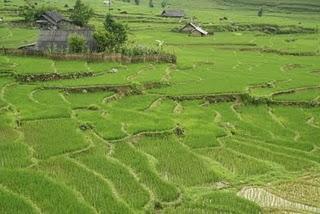

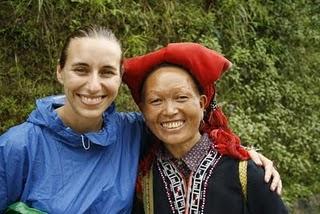
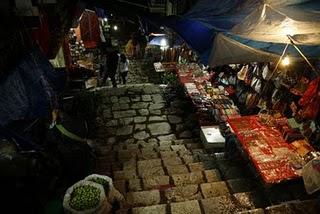

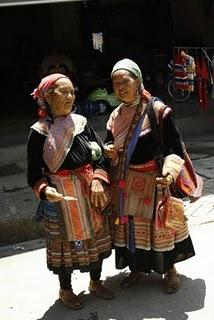
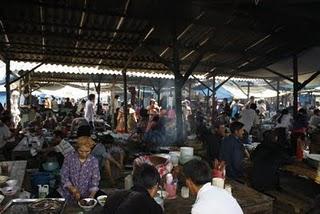
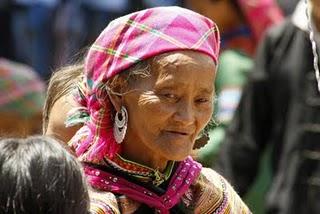
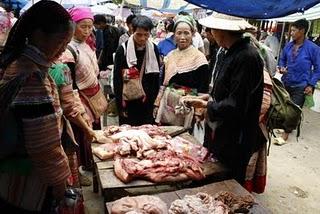

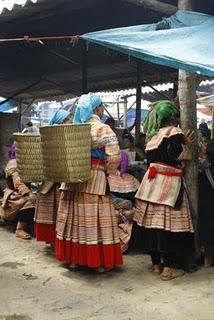

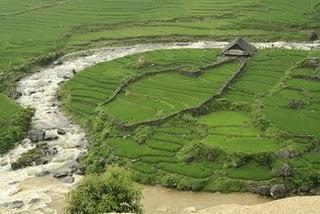
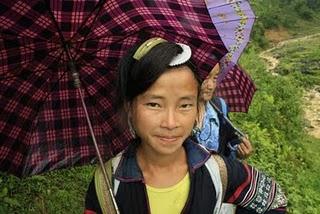

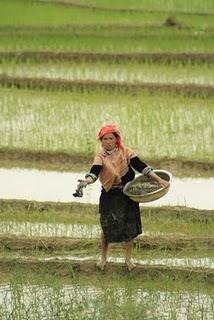
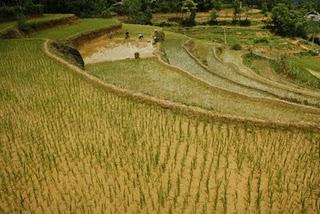

To flee from the heat of Hanoi we reserved two beds in the nighttrain to Sapa (9 hours). The former mountain station in Northwestern Vietnam close to the Chinese border is the starting point for treks to the small villages of the hilltribes. We had a reunion with the Hmong, a people we visited with in Northern Thailand. Unlike the villagers in Thailand the people here mostly still wear their traditional dresses and live primarily from rice farming. On our trek through the incredibly beautiful riceterraces we were accompanied by a troop of enterprising Hmong girls, which in contrast to their Vietnamese counterparts were so charming that we couldn't help but give them a tip for their effort. The next day we visited the Sunday Market in Bac Ha, the biggest in the region. Here you can buy everything you need for the live in the village: buffalos, pork heads (and all other bodyparts), colourful fabric, tools, tabacco, jewellery and plastic sandals. After the happy market buzz we visited a small village close by.
Altough it may seem pretty idyllic, unfortunately the life of the hilltribes is not. Apart from the souvenir selling and the tips the Hmong don't benefit from the many tourists that stroll through their village and peek into their houses. The money from the tours goes completely to the tour operators in the cities. Other than that, the Hmong face another big problem: A woman tells us that her sister did a track with a Chinese businessman through the villages and was kidnapped and broght to China to sell her body in a Chinese brothel. This isn't a isolated case. The few women that come back tell horrible stories. It's to hope for that in the future the Vietnamese governement will take more initiative to ensure the wellbeing of the country's minority groups.




















